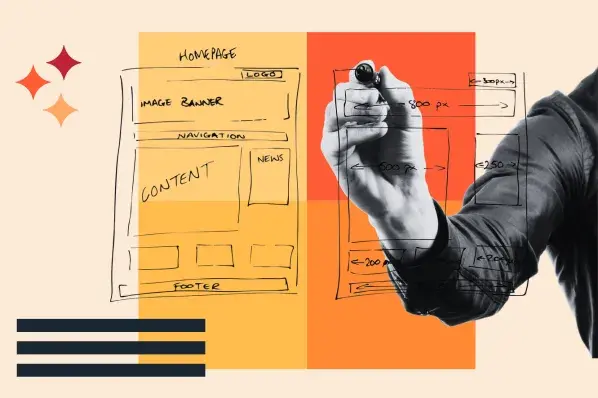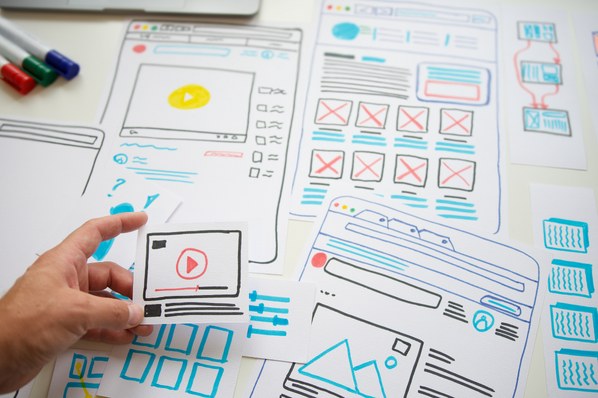I knew how to build websites … but I hadn’t yet learned how to pitch my website design services effectively to potential clients.
I want to spare you from making the same mistakes I did early in my career, so let’s explore my improved approach for sending detailed website design proposals.
Table of Contents
- What is a website design proposal?
- What to Include in a Website Design Proposal
- Website Proposal Template Options
- More Website Proposal Examples
- Website Redesign Proposal
- Tips and Best Practices: How to Write a Website Design Proposal
After you send a website proposal, and before you begin work, you'll need your new client to approve it. This might include asking them to sign a contract, or in more relaxed settings, you may be willing to proceed after they’ve accepted your pricing, timeline, and terms in writing by email.
What to Include in a Website Design Proposal
We’ve mentioned briefly that your website design proposal should include details about how you’ll approach your client’s problems and goals, and that you should present enough information to allow them to make an informed choice to work with you.
But just what should you include in your proposal? Below are eight sections that you can adjust or remove as you see fit.
And I didn’t just pull these sections out of thin air. They’re based on this free website proposal template HubSpot created — and on my experiences as a contractor.
To get started, download the proposal template. We’ll walk through how to fill this out step by step.

For each section, I’ll use the example of crafting a website for Charmaloo, a brand specializing in custom-designed mockup clothing.

1. Cover Letter
This should appear on the first page or first slide of your website design proposal. This will let a busy client see the most information from your pitch at a glance, while also presenting your work to them in a short, compelling fashion.
The cover letter is the first impression, so you’ll want to make sure it is carefully written and proofread.
What to include:
- A header including your business name and contact information.
- A brief introduction to your proposal addressed to your point of contact and referencing their company’s name.
- Context for the proposal, citing your discovery call or their RFP.
- A thank you note to the client for considering your proposal.
- A summary of your service offerings, referencing the project name you’re using for this proposed work.
- Your contact information for follow-up questions.
- The date when the proposal was submitted.
Pro tip: Approach your cover letter in the same tone you might use in a cover letter you’re attaching to a resume when applying for work. Both are used to sell yourself. Write confidently and enthusiastically about your ability and excitement to help them reach their goals. Write briefly about the specific outcomes you are promising in your pitch.
So, for example: “I look forward to working with you on a landing page redesign that helps ABC Co. generate more leads and conversions.”
Sign off with a professional closing, and include an electronic or handwritten signature for a personal touch.
Example
To help illustrate what this might look like in practice, here’s an example cover letter for the Charmaloo brand on behalf of Your Web Solutions (a fictional web services site).
Dear Charmaloo team,
Thank you for taking the time for a call to outline your vision for Charmaloo’s future web presence. Your Web Solutions would be excited to help you develop and release your updated Shopify store with custom features that integrate into your existing CRM and other third-party tooling.
I have put together some timelines and a detailed proposal on how we might be able to work together on the new Charmaloo website. Please feel free to contact me at this email address with any questions or to arrange a call. Thank you again for your time and for considering Your Web Solutions.
Looking forward to working with you.
Best regards,
Jessica Rose
Your Web Solutions
Email: info@yourwebsolutions.com
Phone: (555) 123-4567
2. Our Company
In the cover letter, you provided an overview of your contact with the client and the context of your proposal. Next, let’s tell them more about your agency/company to show them why you’re the best pick for their design work.
What to include:
- A brief history of your company, including founding date/years in operation, mission statement, and number of employees.
- Major accomplishments, such as awards and recognitions, the number of websites your company has built, and any statistics you’re able to share from past projects.
- Notable projects or clients, especially those similar to the prospective client's industry.
Pro tip: Once you write this section for one design proposal, you can reuse it for future clients with little editing needed, just be sure to adjust the tone if necessary. When in doubt, ask a friend in web design to look over your draft before sending.
Here’s another tip from Jackson Gartner, managing director at White Peak Digital:
“When presenting your web design agency, don’t just focus on the pretty designs. Show how your work actually helps businesses grow. Share how you prioritize user experience, mobile responsiveness, and building websites that can scale over time. That’s what really earns long-term trust.”
Example
Talking about your company can feel like bragging, especially if you’re a solopreneur or smaller agency. However, it’s important to show potential clients who they would be working with.
Here’s an example I wrote below.
Your Web Solutions was founded in 2015 to help B2C companies reach more global customers by designing and optimizing websites that delight. We’ve helped design, launch, and manage websites for clients in the fashion, industrial, and agricultural sectors.
Our notable projects include the website design for XYZ Apparel, where we increased online sales by 30% within six months of launch. Our experience in the fashion and creative industries uniquely positions us to understand and meet the needs of Charmaloo.
3. Our Services
You’ve written a great cover letter and introduced your company to your potential new client. Next, let’s tell them more about your company's services. You’ll want to focus on the services that overlap with their needs, but also list additional services where you can upsell as the relationship develops.
What to include:
- A comprehensive list of all services your company offers that are relevant to your client.
- An abbreviated list of services you offer that might be relevant to your client in the future.
Example
It's tricky to strike a balance between listing services your client might be interested in and keeping your list of services concise and to the point. Let’s look at an example for Charmaloo.
We provide a full suite of web services to ensure your website operates at its best from day one. Here's what we offer:
- Website Design and Development
- Website Hosting
- Site Management
- Web Form Testing
- HubSpot CRM Integration
- Graphic Design for the Web
- Photography for the Web
4. Our Proposed Web Design and Development Team
You’ve introduced your company and the services you offer. Now it’s time for your website design proposal to connect on a more personal level. Introducing your team lets you showcase how their individual skills relate to the work you’re pitching to your client and lets them know who they’ll work with during the project.
What to include:
- Introductions to your team members and the role each member will play in this particular project.
- Brief bios that highlight each member’s experience and qualifications.
- You can also include headshots to add a personal touch.
Example
In this project, I included a few team members and topline information about their professional backgrounds and the role they would take. Aim for 2-3 sentences that briefly introduce each team member. If you’re part of a one-person or smaller team, you may want to go into more detail as you introduce yourselves.
Meet our team:
- John Smith, Project Manager. John holds a degree in computer science from State University and has been managing complex web projects for over 10 years. He will be your primary point of contact throughout the process, helping interface with our team to deliver the new Charmaloo website.
- Jane Williams, Lead Developer. Jane specializes in web development and has worked on 50+ high-traffic websites. She’ll mostly work behind the scenes, coding your website to life with constant communication with John to ensure she understands your needs.
- Amanda Bond, Graphic Designer. Amanda is an award winning designer ready to help take the new Charmaloo style guide and build beautiful graphics for your new website. She’ll be working closely with John to make sure everything looks perfect.
5. Problem Statement and Solutions
Your proposal has done a great job so far of telling your future client about you. They know about your company, team, and the services you offer. Now is the time to change your focus to show them that you understand their problem and are ready to solve it for them.
What to include:
- A summary of the client’s problem.
- A summary of your solutions.
- A clear connection between the client’s problem(s) and your solution(s).
- The project’s objectives.
Expert Kyle Prinsloo suggests this in one of his amazing YouTube tutorials: “The key is to use the same language your client uses when they talk about the goal and the problems they need to solve. It‘s important that you don’t use jargon that the client won't understand.”
Pro tip: When writing about how you’ll solve client problems, talking about the specific tools you would use helps make the work proposed more concrete to your clients. For instance, if you’ll use a HubSpot account with hosting to address a marketing need, a WordPress theme for a design problem, or other tools to address their goals, talk about them in this section.
Example
In this example, I outlined the project goals in a simple, easy-to-read way to explain to the client what they will gain and how they can benefit from collaborating with us.
Problem: Charmaloo is a rapidly growing ecommerce brand, but its current WordPress site, built using a premade template, is holding back its growth.
Solution: Create a visually stunning, custom Shopify site for Charmaloo that showcases products and personalized digital illustrations, streamlines the checkout process, and connects customer data with its CRM. This new Shopify site will attract Charmaloo’s ideal customers, boost conversions, and ultimately, drive greater profit.
Furthermore, our expert team will:
- Enhance website performance.
- Boost traffic.
- Align with your strategic goals.
Choose us as your design and development partners, and we'll optimize performance, prevent downtime, strengthen security, and ensure your site becomes the most powerful tool for your business.
6. Scope of Work: Deliverables and Timeline
This section clearly outlines the scope of work, including deliverables and when they’re due. Be as specific as possible here to avoid the dreaded scope creep.
What to include:
- Major deliverables for designing and developing the website.
- Timeline for when each deliverable will be completed.
- Start and completion dates for each deliverable.
Hear from an expert: Here's what graphic designer Gloria Condy advises: “You can ask more questions and get a better understanding of what their visions are. Don't leave any stone unturned. If you have anything that you are unsure about, ask them.”
Example
|
ACTIVITY |
START DATE |
COMPLETION DATE |
|
Discovery |
5/01/2025 |
5/10/2025 |
|
Website Design |
5/10/2025 |
5/15/2025 |
|
Website Development |
5/15/2025 |
5/30/2025 |
|
Quality Assurance |
5/30/2025 |
6/7/2025 |
7. Pricing and Payment Schedule
Working with your business manager and the client’s budget in mind, calculate the hours of work involved based on your rates. Then, provide the client with a detailed quote so they can determine whether or not it aligns with their ROI.
Your quote should include all work involved on your or your agency’s side.
|
PROJECT/SERVICE |
TIME |
QUOTE |
|
Domain setup |
1 hour @ $100/hr |
$100 |
|
Shopify development |
30 hours @ $200/hr |
$6,000 |
|
Content production — five pages and three landing pages |
8 hours @ $170/hr |
$1,360 |
|
Content production — on-page SEO strategy |
8 hours @ $170/hr |
$1,360 |
|
Total |
$8,820 |
If your client is working with other photographers, designers, or writers, only include what work you or your agency will do for this project. You may need to add a little overhead to your hourly rate to make your own ROI worth it. That is perfectly acceptable.
You have costs to consider, beyond time, including:
- Office space rent
- Hiring subcontractors
- Electricity bills
- Internet bills
- Design software subscriptions
Your quotes to your clients should help you cover all of these costs within reason.
What to include:
- A breakdown of your fees
- Payment schedule details
- Payment methods
Example
|
ITEM |
DEADLINE |
COST |
|
Initial Deposit |
50% due upon signing |
$4,410 |
|
Website Design Fee |
Final 50% due upon completion |
$4,410 |
|
Total |
$8,820 |
Hear from an expert: Curious about how to break down your payment schedule? Keep in mind that tying your final payment to the project’s completion could unintentionally hurt your cash flow since projects might go on longer than expected — through no fault of your own.
Here’s a tip from Beverley Delay, founder of sustainable web design agency Beverley Designs. She recently changed her payment schedule to require a 50% upfront payment, with the remaining 50% invoiced 30 days from the start date.
“This ensures I get paid in a reasonable amount of time,” Delay tells me, “and it provides incentive for the client to send me all the information needed for the site content so we can get the website up and running quickly.
“In the past, I would invoice 50% upfront and 50% when the site went live. Sometimes, my clients would get busy and several months would go by from the time the project began, so I was waiting to invoice the final amount for months.
“My current practice ensures that I get paid the full amount in the same month, so it’s much better for my own cash flow.”
8. Signatures and Agreement
At the end of the day, the web design proposal must sway the client to do business with you. To do this, you need them to sign! Make it easy by using e-signature software to send your proposal.
What to include:
- Instructions for finalizing the contract, such as a signature and deposit payment.
- The link for them to make their initial payment.
- Space for the client’s and your company’s representatives to sign.
Website Proposal Template Options
Lucky for you, I’ve got three free HubSpot templates you can download, tweak, and use as you see fit.
Web Design Proposal Template
![]()
This is a standard web design proposal template that I’ve been referencing throughout this article. It focuses on web design and development services and contains the following sections:
- Cover Letter
- Our Company and Team
- Our Services
- Our Proposed Web Design Team
- Project Objectives
- Major Activities and Timeline
- Pricing and Payment Schedule
- Signatures and Agreement
- Gallery
Website Proposal Template

Slightly differing from the template above, this website proposal template focuses on website management and hosting services. Use this one if you want to propose post-launch website management and support to your existing design clients.
It contains the following sections:
- Cover Letter
- Our Company and Team
- Our Services
- Our Proposed Web Management Team
- Project Objectives
- Major Activities and Timeline
- Pricing and Payment Schedule
- Signatures and Agreement
Business Proposal Template

This flexible business proposal template can easily be adapted to web design services. It contains the following sections:
- Understanding of the Problem
- Proposed Solution
- Pricing Information
- Proposed Schedule
- Conclusion
- Terms and Conditions
- Appendices
More Website Proposal Examples
To help you get started, let’s take a look at three more website proposal examples and what makes them great.
Website Proposal Example #1: Showing Off Design Skills

This website proposal example is from a free 10-page Canva template. I particularly liked this proposed timeline page because it visually lays out the phases of the web design and development process.
Website Proposal Example #2: Adding Photography for a More Engaging Proposal

This vibrant website proposal example is from a free 12-page Canva template. I like the personal touch of adding a team photo to the “About Us” section of a proposal to humanize your brand to your prospective clients.
Website Proposal Example #3: Including Client Testimonials for Social Proof

You can modify this 13-page free Canva project proposal template to fit your web design services. What I enjoyed most about this example is that it shows how you can incorporate client testimonials into your website proposal to try to boost close rates.
Website Redesign Proposal
We’ve been exploring how to propose web design work to a client’s known needs.
However, when proposing work for a website redesign, you may be helping your client understand their needs through your proposal. This means that the focus of your proposal will change to a more exploratory and open-ended approach. A website redesign proposal differs from a standard proposal in three aspects: focus, content, and goals.
Focus
- Standard proposal: Explains the web services you'll provide and the value you bring to a new client when creating their website.
- Redesign proposal: Focuses on improving an existing website, analyzing its strengths and weaknesses, and outlining how to achieve specific goals through redesign.
Content
- Standard proposal: Highlights your company's experience, skills, and approach to the project at hand.
- Redesign proposal: Dives into the specifics of the existing website, including user experience (UX) evaluation, competitor analysis, and the client's target audience.
Goals
- Standard proposal: Persuades the client to choose your company for their project.
- Redesign proposal: Convinces the client that a website redesign is necessary and outlines the measurable benefits it will bring.
Tips and Best Practices: How to Write a Website Design Proposal
1. Use standardized pricing structures to guide your quote.
Quoting pricing appropriately is one of the most difficult things to learn in your first few pitches to clients. Pricing varies by region and industry, but you can start from a place of confidence by researching what your competitors charge for different types of services.
If you’re doing competitor pricing research, it can be tempting to hide your own pricing from your website and only share it in your website design proposals. This is a personal choice many take, but listing your pricing on your website will increase the chances that potential clients will contact you about work.
Pro tip: It can be tempting to quote very low prices to get your first few clients, but I’ve found that listing prices that are similar to your competitors can help your clients feel confident in the quality of your work. If needed, you can always offer individual clients discounts in exchange for being allowed to use your work for them in your portfolio to help with winning those first few clients.
2. Be upfront with your client about who is doing the work.
If you need to hire help, include the cost in your quote. If you need the client to provide materials, ask at the start of the project.
Don’t assume the client knows to hire photographers for a roster photoshoot, for instance. They may expect you to drive all aspects of the project.
It can be tempting to subcontract tasks out, especially as a smaller company. If you need to bring additional help to the project, be sure that you communicate this clearly and early to your client.
Clients often rightly consider access to their business documents, designs, and website to be confidential information. It’s better to ask for permission before adding new people to your client project than to have to ask for forgiveness after something has gone wrong.
3. Gather all of the information you need upfront.
Designing a website for your client is a collaborative exercise that will involve several conversations and check-ins as you work.
To balance clear communication and efficiency, take the time to get as much information as possible early in the project, and keep detailed notes from your first few conversations with your new client.
I like to send new clients an onboarding survey at the start of a new project. The goal of this survey is to get information about the project and their working patterns.
I often like to include questions about the following in my onboarding surveys:
- Branding assets for their project and company.
- Style guides.
- Company mission statement and values.
- Information on ways of working:
- How do they like to communicate during projects?
- How often do they want to check in during the project?
- How do approvals work?
- Who needs to approve changes to your work versus who needs to approve or accept the work you’ve completed.
- Acceptance criteria: When is this project considered finished?
There are often multiple stakeholders in a web project, which can lead to requirements changing as your project evolves. By collecting and keeping careful details about their expectations, you can minimize last-minute changes and keep your client happier.
Write your winning website proposal.
I’ve written and received countless design proposals over the years, and I can tell you that website design proposals that are carefully designed and filled with relevant detail are more likely to win.
While it might feel like a huge ordeal to create your first few website design proposals, you’ll find this process gets easier with time, experience, and the use of templates. Happy pitching!
Editor's note: This post was originally published in March 2023 and has been updated for comprehensiveness.

-Oct-23-2025-03-34-31-8363-PM.webp)
.png)
![How to create a website to sell products: 7 steps I used [+ expert tips]](https://53.fs1.hubspotusercontent-na1.net/hubfs/53/how-to-create-a-website-to-sell-products-1-20240909-6141294.webp)





.png)
-2.png)

